Allan Smith is an artist and the Creative Director of Allenheads Contemporary Arts in Allenheads, Hexham, Northumberland, established in 1994; in the hope to create new opportunities for artists and new works. He has previously worked alongside Edith in a curatorial project Platform P at the Duke in 2011.
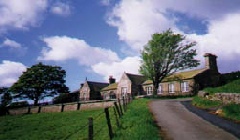
A photograph of The Old Schoolhouse, Allenhead
Available at:
http://www.acart.org.uk/aboutus.html
Alienhead:
Alan talks about it is crucial for him and his partner Helen Ratcliff, to have people that can feed them as artists, so that they can become equal and have power. He explains that although it is a wonderful place to live at first it was a difficult place to make work. in comparison to where he had previously lived in New York. Due to things always moving whereas, in Allenheads there isn’t much movement.
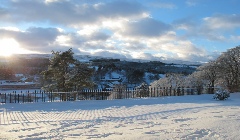
A photograph of view from Old school house, Allenhead,
Available at:
http://www.acart.org.uk/aboutus.html
When he first moved he tried to paint the landscapes, as he thought that was what artists should do, this didn’t work so he threw the canvases outside. A few days later when walking his dogs he walked past the rubble of paintings and one particular painting in specific caught his eye. When he looked closer there was dirt and mould growing over the canvas, this was the realisation to him that things were happening in Allenhead. He talked about how when you go into a new place you almost put an Allienhead on. You think you know what’s going on but invert-idly it is something else. You have to go to it’s pace to engage with it.
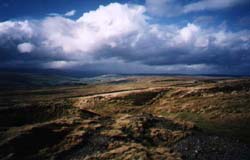
A photograph of the view from Allenhead,
Available at:
http://www.acart.org.uk/page5.html
This brought him to ask himself to consider feelings and understand the landscape and its relevance to you; or if an aspect is relevant. ‘Always go in with open eyes and a blank head, but don’t deny your knowledge bank.’
He often would take a students to the grouse hunting ranges, and blind fold them on the journey to the space. This challenges differences in landscapes, by blindfolding them is allows decompression, and he promotes silence. Allowing no camera’s, phones or other device’s he would exclaim ‘ You are the recording device.’ By leaving them on their own for an hour or so, then retrieving them all, and placing them in a group they would collectively talk about what it was like. This promoted various background expressions on the experiences, and their differences when discussing these experiences, this therefore assisted a collective understanding of the experience. He noted that an empty landscape allows a student to view their perceptions of size compares to their normally non rural landscapes filled with lamposts and other objects.
When speaking about Allenhead, after showing us pictures he reminded us that the weather wasn’t always sunshine and blue skies, often you were up in the clouds, and he enjoyed this word play, and that the winters were extreme and ofter reclusive.
Education:
He bases his working from an old victorian schoolhouse, that is divided into sections: accommodation, school house, headmaster’s court (where Alan and his partner live) and a Gallery space. When they first arrived no one really believed int he arts, so they really had to push their idea’s forwards. Amongst Alan there are other teachers, he gave the example of Allen Dubsen, an eco taxonomist, who makes courses for people and locals to look and understand their immediate environment. Dubsen talks about the behaviour of plants and their surrounding altitude on Fungi forages.

A photograph of the Old School House, Allenhead
Available at:
http://www.acart.org.uk/index.html
Smith and the Allenheads Contemporary Art (ACA) work alongside various departments from universities and colleges, from Ba students to Ma students and recent graduates, helped to promote the interpretations of peoples notions towards place and environment and the contemporary issues surrounding this, he hopes to allow student to challenge stereotypical perceptions. Some of the activities he does with student’s include navigation projects, suing navigation helmets, connected to oranges through hoops int he ceiling, this related to how we find out way around a place, and what we require to navigate, he explains how you can tell where a person is by the positioning of the oranges.
Alongside this Alan also teaches in the Life work Art program at Newcastle University, running projects with schools and creative partnerships, helping to further engage pupils.
The village:
Allenhead is England’s highest village at 1350 feet, with the population of around 200 people, just an hour away from Newcastle and various other cities. With one pub, one cafe, one mechanic, one contemporary arts venue, not a competitive place to live. In 2007 the ACA put it to the trust who run the old village shop and post office, they converted it into an open studio and exhibitions space which also houses films, performances and workshops, he feels it gives a presence to the village being situated in the center, this is when they felt they had started to establish themselves within the village.
As part of a residency this space was used as a studio for two students, with free accommodation in exchange for 4 hours work a day. It is from this space and the school house that innovative projects are developed and presented to a wide audience varying from farmers, dentists, artists, believing they are providing something really ‘rich.’
The first exhibition was by Andrew Wilson, to which they asked the community to give in an object of importance to them, hoping to build a collection of individual histories. After the exhibitions these items were to be collected of donated as a form of trading, in ex-change for the item they previously put into the exhibition, this exhibition was called Trading Post.
Alongside this the Allenheads compiled a playlist made up of people in the communities top 10 songs, collecting various tastes of music, this playlist The Allenheads music collection was played in the ACA shop and can still be listened to on the following link http://www.acart.org.uk/acasounds.html
These sorts of activities help to build the tremendous relationships with the local community as when the ACA begun no one wanted to fund it, the arts council had said you don’t have the catchment, Alan and his wife thought screw this, we can make it happen. They learnt from experience the first exhibition was a ‘white cube exhibition’ with wine and beer and it failed dramatically. With the next exhibition they had a large pot of stew, a barrel of beer, and the event ‘party’ worked so well… from this event the word got out that if you go to Allenheads you’ll have an amazing time. The turning point was when a person from the art council came to an exhibition and were stood outside as it was so busy they couldn’t get it, he said ‘I’ve got to say that’s what you have to do, you will always have to prove something to somebody.’
Artists:
The ACA began working with James Turrell after the Arts council got in touch asking would they represent the project, Smith worked with James to photograph the landscape, this helped to prove to locals it would fit in. In the end the project failed as no one wanted to commit who was in power due to the controversy surrounding it, Smith stated it was mainly due to politicians being pr savvy and pr cynical. The project was taken from them after they had found land and location; a quarry fly tipping dump and even had money for maintenance, but the project went to Kilda and became focused around architecture and now astronomy. Smith felt that the council decided to put it somewhere were people wouldn’t question it, which he feel isn’t what it should be about.
Other artists Smith the ACA have worked with are Helen Smith, with her series of paintings of architecture drawings on how to build a village hall, changing these designs by speaking to people, he showed us the example of a place to laugh and play table tennis. Helen Wakeham, in her parachute project, to be viewed from from gardens of through projections in the classroom, of the drop from camera’s.
Pete Evans, who previously worked at space xx, with his residency Base Elements. Evans references Einstein’s theory from 1905 Formerly known as the equation E=mc2. Further looking into the transformation of matter and it’s mass-energy’s ability to transform from one state to another yet cannot be destroyed or created. Questioning sciences role in comparison to emotional matters in a persons understanding of the world around us. By looking further than science at the immovable objects that are constantly surrounding us, in relation to Allenhead this meant the development of materials that were within the valleys and various surroundings.
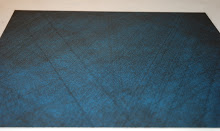
A photograph of A panel study for installation Base Elements, 2008
Available at:
http://unseencolourfield.blogspot.co.uk/
Kypros Kyprianou, also for the residency Base Elements, created a car boot sale Periodic table made out of objects collected from car boot sales, which were mainly compounded of each element, and ordered by their ordering within the periodic table. £142 was made from the selling of elements. An A-Z guide of objects to elements can be found at : http://www.electronicsunset.org/node/459

A photograph of A Car Boot Sale of The Elements, 2007/8
Available at:
http://www.electronicsunset.org/node/1339
Smith also mentioned as part of a project called The future 2, 3&4, David Lisser, asked What will the future hold for us; food. Working in Allenhead he made a connection to the vast amount of midges and that the oil and gas supplies would be far gone for a remote village. With extremely cold winters the extinction on larger animals and less fresh produce, he related back to Normadic tribes by making Midge-catchers, or in his case a Midge catcher hut. As he had previously discovered they are highly nutritious. He then made these into midge burgers and sold them at the exhibition, yet only needing to make small burgers as they are so nutritious. Lisser called this piece The Midge Catcher’s House.
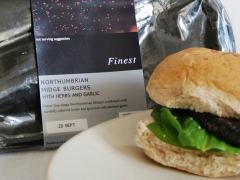
A photograph of a Midge burger, 2013
Available at:
http://www.acart.org.uk/futures234.html
In comparison, for the same project, Smith made a piece called 2045, as his approach to the future. He believed that although things will change we will still be doing the same thing. He used the example that before smart phones you had to look someone in the eye and say I love you, but now you are doing the same but with the technological advancements.
His piece 2045, number of years after. Approach to idea of future, things will change but we will still be doing the same thing. Before smart phones you had to still look someone in the face and say I love you… Technology advancement. It was set close to home in his village Allenheads, with its precious plant life nurtured in domestic Poly Tunnels.
‘For the content of the video I have drawn on the 1972 film Silent Running, in which a future is depicted when all plant life on Earth has been made extinct. Only a few species have been preserved in enormous, greenhouse-like domes attached to a fleet of space ships, with the intent of eventual return to earth for the reforestation of the planet.’ – Smith, 2013
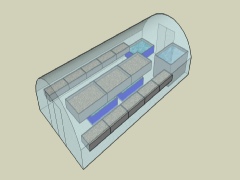
A Image of 2045, 2013
Available at:
http://www.acart.org.uk/futures234.html
This exhibition also including Liam Murray, aimed to explore their personal invisions of what the future would look like, challenging the public to look past the comfortable limitations of our human abilities. Smith mentioned that links occur by working with people from other fields.
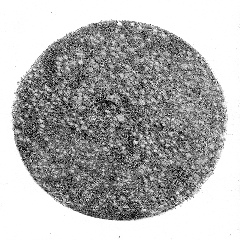
An image of Liam Murrays, Hypothesis Non Fingo,2013
Available at:
http://www.acart.org.uk/futures234.html
Arturas Raila, worked in Allenheads on the final chapter of his piece Power of the Earth, which had been worked on for 3 years in various places including Berlin. Ralia brought over Lithuanian Jonas Trinkunas and pagan family who carried out a Pagan ritual on the top of a hill, to mark the opening of Ralia’s exhibition in Allenhead, that displayed large geo-energy flow maps, alongside photographs of the landscape. This project caused some controversy from the village locals due to it being a Christian community, and the locals wondering why they were in the community.
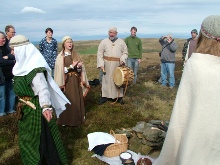
A photograph of a Pagan Ritual, Allenhead,
Available at:
http://www.acart.org.uk/page22.html
For Migrating art residency, Alan Smith made the piece 5% as far as the eye can see. This piece originated from Smiths thinking that :
‘How does someone living in ‘England’s last wilderness’, with its big skies and 360 degree views, make sense of the idea that there is another 95% out there that cannot be felt or seen?’ – Smith, 2013
14 other artists joined him with asking similar questions, prior to the residency Smith engaged in conversations with physicist Dr. Peter Edwards, who claimed the universe is made up of 27% dark matter and 68% dark energy an 5%seeing, an oceanographer Nicholas Owens, the led his practice into conversations with two zen monks who believe meditation allows you to look inwards to the 95% that is missing. Smith enjoyed these contrasting arguments for the missing 95% and believe it’s as important to look outside as inside, and that they weren’t aiming to become scientists yet the practitioners methodologies helped them to develop and question their practice. He asks the question Can imagination and creativity help us make sense of the inexplicable? and further states that he likes to make things as an artist as he doesn’t understand things around him. When he works it out it upsets him. Like the carrot dangling infront of him. He’s an artist maybe its right for him to consider what it means to understand it. He also asks just because you can’t see something does it mean its not there or real.
They found by putting this stuff out there it allowed people to talk about the different experiences by referencing them. Gravity boots, story boxing only allowed to read if you go back.to place. Umbrella. Performances. Contemplation spaces.
Furthermore, he like’s to think and consider what it means to him to live on this world. Asking the question Can imagination and creativity help us to make sense of the inexplicable? Projects don’t come.out of air, a shut load.of work and are all linked together somehow.If for any reason you can’t do something, adversity, go home and your brain will figure it out. He stated Make work that’s relevant to you. Not just because you saw something in a magazine.
Contact:
http://www.acart.org.uk
http://www.alansmith.org.uk
alanshead@acart.org.uk
References:
Acart.org.uk. 2013. futures234. [online ] Available at: http://www.acart.org.uk/futures234.html [Accessed: 24 Oct 2013].
] Available at: http://www.acart.org.uk/futures234.html [Accessed: 24 Oct 2013].
Colourfield, I., Colourfield, I. and Profile, V. 2008. Base elements 1.2. [online ] Available at: http://unseencolourfield.blogspot.co.uk/ [Accessed: 24 Oct 2013].
] Available at: http://unseencolourfield.blogspot.co.uk/ [Accessed: 24 Oct 2013].
Electronicsunset.org. 2013. Base Elements | Hollington & Kyprianou. [online ] Available at: http://www.electronicsunset.org/node/356 [Accessed: 24 Oct 2013].
] Available at: http://www.electronicsunset.org/node/356 [Accessed: 24 Oct 2013].
Electronicsunset.org. 2013. An A-Z guide to the elements | Hollington & Kyprianou. [online] Available at: http://www.electronicsunset.org/node/459 [Accessed: 24 Oct 2013].
Migaa.eu. 2013. Migrating Art Academies | Review: 5% as far as the eye can see. [online] Available at: http://www.migaa.eu/review-5-as-far-as-the-eye-can-see/ [Accessed: 24 Oct 2013].
Newsandstar.co.uk. 2013. News & Star | Pagan ceremony launches art show. [online] Available at: http://www.newsandstar.co.uk/pagan-ceremony-launches-art-show-1.184124?referrerPath=home/2.1962 [Accessed: 24 Oct 2013].
Raila.lt. 2013. Power of the Earth / Artūras Raila. [online] Available at: http://www.raila.lt/power-of-the-earth/ [Accessed: 24 Oct 2013].